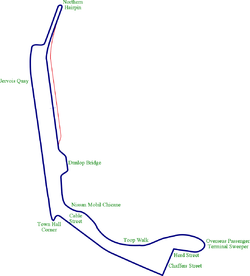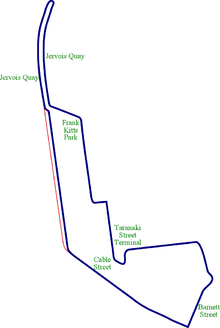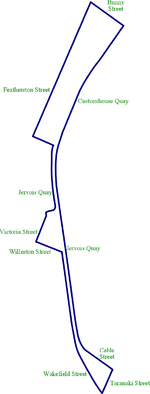Wellington 500

The Wellington 500 was a 500 km (310 mi) street race for touring cars which took place at Wellington City in Wellington, New Zealand. The race was first proposed in 1984 and first took place a year later, albeit with a different layout from that to the original proposal. The final running of the race was in 1996, a non-championship event for the Australian Touring Car Championship.
History
Beginnings (1985-86)
Initially dubbed the Nissan Cue 500, the first event in 1985's title was changed at the last minute to the Nissan Sport 500 due to Cue Magazine's demise in the week preceding the event. The following year Mobil became a naming sponsor and the Nissan Mobil 500 name was born.
The Nissan Mobil 500 was actually a two-event series with the first round being held at the Wellington Street Circuit and the second at Pukekohe Park Raceway south of Auckland, the Pukekohe 500.
For the first race in 1985, the FIA delegate who inspected the Wellington Street Circuit was 1960 Armstrong 500 winner John Roxburgh from Australia. He voiced serious concerns about the narrowness of the circuit as well as safety and the circuit did not pass inspection. For the race to be able to go ahead the promoters had to re-write the regulations turning the event from an international race to a national race, thus eliminating the need for FIA approval.
WTCC round (1987)
In 1987, the Nissan Mobil 500 Wellington Street Race was a round of the inaugural FIA World Touring Car Championship. The WTCC lasted only one year and was a victim of its own Group A rules. Both the factory backed BMW Motorsport (Schnitzer) and Ford (Eggenberger) teams were disqualified from some races for technical infringements. Also, Formula One boss Bernie Ecclestone had been given power over the WTCC at the last minute over the original organisers, the NZ based Strathmore Group. Ecclestone imposed a US$60,000 registration fee per car which saw only a small number of cars eligible for championship points. With some races decided by stewards hearings, the WTCC generally descended into a farce by the end of 1987 and the series was not run again in 1988.
Continued international exposure (1988-94)

The race maintained a point of interest for international teams and drivers in the years following the WTCC event. The event lived through several different types of touring car classes, from Group A to Super Touring and then Group 3A, a class adopted by the Australian Touring Car Championship (ATCC), now known as V8 Supercars, from 1993 onwards.
Demise and final sprint round (1995-96)
After no event was held in 1995, the circuit was used for a final time in 1996, as a non-championship ATCC event. Twelve cars competed in the event, as part of a two-event series in New Zealand which also included races at Pukekohe Park Raceway. The format consisted of three short sprint races, and the overall winner was John Bowe for Dick Johnson Racing.
Despite its popularity, the race never returned after 1996 due to political reasons.
Failed revival plans
In 2004, there were plans to revive the race as a V8 Supercars event, to feed on its high popularity in New Zealand, with many popular New Zealand drivers competing in that series in Australia. As the roads where the circuit used to be have now been demolished to make way for a museum and other buildings, it would have had to be run on a new course. There was a new proposal in 2006 with a new layout. Both of the 2006 Proposals were revoked through the Resource Management Act.


The proposed race was eventually dropped in favour of the Hamilton 400 at the street circuit of Hamilton, which hosted V8 Supercars from 2008 to 2012.
Layout
During 1985-1996 the track changed layout many times. The circuit initially ran along Cable Street to the Taranaki Street Gates, and this was extended to the Hurd Street Loop for the 1987 WTCC event. The extensions for 1987 also included Horseshoe Hairpin being lengthened. By 1991 the back straight (Jervois Quay) was modified to make a safer turn onto Cable Street. For 1993 the layout was forced to change due to the construction of the Queens Wharf Events Centre and Te Papa (Museum of New Zealand), which meant the loss of the "traditional" layout.
Winners list
| Year | Driver | Car |
|---|---|---|
| 1985 | | Volvo 240T |
| 1986 | | Holden VK Commodore SS Group A |
| 1987 Feb. | | Holden VK Commodore Group SS A |
| 1987 Nov. | | Ford Sierra RS500 |
| 1988 | | BMW M3 |
| 1989 | | BMW M3 |
| 1990 | | BMW M3 |
| 1991 | | BMW M3 Evolution |
| 1992 | | BMW M3 Evolution |
| 1993 | | Porsche 911 RS Cup |
| 1994 (race 1) | | BMW 318i |
| 1994 (race 2) | | BMW 318i |
| 1996 | | Ford EF Falcon |
See also
External links
- Guido de Carli's track guide
- Wellington V8 Westpac Stadium Track
- Wellington street race proposal
- E-Tracks Online Circuit Map